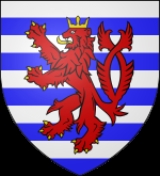
List of monarchs of Luxembourg
Encyclopedia
The territory of Luxembourg
was ruled successively by count
s, duke
s and grand duke
s. It was part of the medieval Kingdom of Germany
, and later the Holy Roman Empire
until it became a sovereign
state in 1815.
As Elisabeth had no surviving children, she sold Luxembourg to Philip III, Duke of Burgundy
in 1441 but only to succeed upon her death. Philip captured the city of Luxembourg
in 1443, but did not assume the ducal title because of conflicting claims by Anne of Austria
, the closest Luxembourg relative.
, last rival claimant to the title, renounced her rights, Philip III's son, Charles, Duke of Burgundy, assumed the title of duke of Luxembourg, making it a subsidiary title of the Duke of Burgundy
.
During the War of Spanish Succession, 1701–1714, the duchy was disputed between Philip of Anjou
, grandson of Louis XIV of France
, from the House of Bourbon
and Charles of Austria
, son of Leopold I, Holy Roman Emperor
, from the House of Habsburg. In 1712 Luxembourg
and Namur
were ceded to Maximilian II Emanuel, Elector of Bavaria
by his French allies, but with the end of the war in 1713 with the Treaty of Utrecht Max. Emanuel was restored Elector of Bavaria. In 1713 the duchy fell to the Austrian branch of the House of Habsburg.
Luxembourg was occupied by French revolutionaries between 1794 and 1813. At the Vienna Congress, it was elevated to a grand duchy and given in personal union to William I of the Netherlands
.
of Luxembourg
. Luxembourg is the world's only sovereign extant Grand Duchy
, a status to which Luxembourg was promoted in 1815 upon its unification with the Netherlands under the House of Orange-Nassau
.
The Luxembourgian constitution
defines the Grand Duke
's position:
, those territories of the Nassau family in the Holy Roman Empire
at the time of the Pact (Luxembourg and Nassau
) were bound by semi-Salic law
, which allowed inheritance
by females or through the female line only upon extinction of male members of the dynasty
. When William III
died leaving only his daughter Wilhelmina
as an heir, the crown of the Netherlands, not being bound by the family pact, passed to Wilhelmina. However, the crown of Luxembourg passed to a male of another branch of the House of Nassau: Adolphe
, the dispossessed Duke of Nassau and head of the branch of Nassau-Weilburg.
In 1905, Grand Duke Adolphe's younger half-brother, Prince Nikolaus Wilhelm of Nassau
, died, having left a son Georg Nikolaus, Count von Merenberg
who was, however, the product of a morganatic marriage
, and therefore not legally a member of the House of Nassau. In 1907, Adolphe's only son, William IV, Grand Duke of Luxembourg, obtained passage of a law confirming the right of his eldest daughter, Marie-Adélaïde, to succeed to the throne in virtue of the absence of any remaining dynastic
males of the House of Nassau, as originally stipulated in the Nassau Family Pact. She became the grand duchy's first reigning female monarch upon her father's death in 1912, and upon her own abdication
in 1919, was succeeded by her younger sister Charlotte
, who married Felix of Bourbon-Parma
, a prince of the former Duchy of Parma
. Charlotte's descendants have since reign
ed as the continued dynasty of Nassau, and also constitute a cadet branch
of the House of Bourbon-Parma.
Luxembourg
Luxembourg , officially the Grand Duchy of Luxembourg , is a landlocked country in western Europe, bordered by Belgium, France, and Germany. It has two principal regions: the Oesling in the North as part of the Ardennes massif, and the Gutland in the south...
was ruled successively by count
Count
A count or countess is an aristocratic nobleman in European countries. The word count came into English from the French comte, itself from Latin comes—in its accusative comitem—meaning "companion", and later "companion of the emperor, delegate of the emperor". The adjective form of the word is...
s, duke
Duke
A duke or duchess is a member of the nobility, historically of highest rank below the monarch, and historically controlling a duchy...
s and grand duke
Grand Duke
The title grand duke is used in Western Europe and particularly in Germanic countries for provincial sovereigns. Grand duke is of a protocolary rank below a king but higher than a sovereign duke. Grand duke is also the usual and established translation of grand prince in languages which do not...
s. It was part of the medieval Kingdom of Germany
Kingdom of Germany
The Kingdom of Germany developed out of the eastern half of the former Carolingian Empire....
, and later the Holy Roman Empire
Holy Roman Empire
The Holy Roman Empire was a realm that existed from 962 to 1806 in Central Europe.It was ruled by the Holy Roman Emperor. Its character changed during the Middle Ages and the Early Modern period, when the power of the emperor gradually weakened in favour of the princes...
until it became a sovereign
Sovereignty
Sovereignty is the quality of having supreme, independent authority over a geographic area, such as a territory. It can be found in a power to rule and make law that rests on a political fact for which no purely legal explanation can be provided...
state in 1815.
Elder House of Luxembourg
| Image | Name | Date of birth | Date of death | Reign | Relationship with predecessor |
|---|---|---|---|---|---|
| Siegfried Siegfried of Luxembourg Siegfried is considered the first count of Luxembourg. He was actually count in the Moselgau and the Ardennes. He was also the advocate of the abbeys of Saint-Maximin de Trêves and Saint-Willibrod d'Echternach. He is speculated to be the son of Wigeric of Lotharingia, Count Palatine and Cunigunda... |
922 | 28 October 998 | 963 to 28 October 998 |
||
 |
Henry I Henry V, Duke of Bavaria Henry , of the House of Luxembourg, was the count of Luxembourg from 998 and the duke of Bavaria from 1004... |
964 | 27 February 1026 | 28 October 998 to 27 February 1026 |
his son |
 |
Henry II Henry VII, Duke of Bavaria Henry VII was the count of Luxembourg from 1026 and duke of Bavaria from 1042 until his death. He was the son of Frederick, count of Moselgau, and possibly Ermentrude of Gleiberg.... |
1007 | 16 October 1047 | 27 February 1026 to 16 October 1047 |
his nephew |
| Giselbert Giselbert of Luxembourg Giselbert of Luxembourg was count of Salm and of Longwy, then count of Luxembourg from 1047 to 1059. He was the son of Frederick of Luxembourg, count of Moselgau, and perhaps of Ermentrude of Gleiberg.... |
1007 | 14 August 1059 | 16 October 1047 to 14 August 1059 |
his brother | |
 |
Conrad I Conrad I, Count of Luxembourg Conrad I, Count of Luxembourg was count of Luxembourg , succeeding his father Giselbert of Luxembourg.He was embroiled in an argument with the archbishop of Trier as to the abbaye Saint-Maximin in Trier which he had avowed. The archbishop excommunicated him Conrad had to make honourable amends and... |
1040 | 8 August 1086 | 14 August 1059 to 8 August 1086 |
his son |
 |
Henry III Henry III, Count of Luxembourg Henri III, Count of Luxembourg was count of Luxembourg , in succession to his father Conrad. His mother was Clementia of Aquitaine.He never married and was succeeded by his brother William.... |
1070 | 1096 | 8 August 1086 to 1096 |
his son |
 |
William I William I, Count of Luxembourg William I, Count of Luxembourg was count of Luxembourg , in succession to his elder brother Henry III of Luxembourg. They were both sons of Conrad and Clementia of Aquitaine... |
1081 | 1131 | 1096 to 1131 |
his brother |
 |
Conrad II Conrad II, Count of Luxembourg Conrad II of Luxembourg was count of Luxembourg , in succession to his father William I of Luxembourg. His mother was Mathilde or Luitgarde of Northeim.... |
1106 | 1136 | 1131 to 1136 |
his son |
House of Luxembourg-Namur
| Image | Name | Date of birth | Date of death | Reign | Relationship with predecessor |
|---|---|---|---|---|---|
 |
Henry IV the Blind |
1112 | 14 August 1196 | 1136 to 14 August 1196 |
his first cousin |
House of Hohenstaufen
| Image | Name | Date of birth | Date of death | Reign | Relationship with predecessor |
|---|---|---|---|---|---|
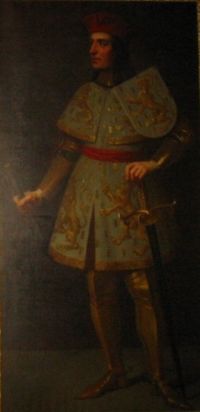 |
Otto | June/July 1170 | 13 January 1200 | 1196 to 1197 |
his third-cousin once removed |
House of Luxembourg-Namur
| Image | Name | Date of birth | Date of death | Reign | Relationship with predecessor |
|---|---|---|---|---|---|
| Ermesinde | July 1186 | 12 February 1247 | 1197 to 12 February 1247 |
Henry IV's only daughter and Otto's fourth cousin | |
 |
Theobald I | 1158 | 13 February 1214 | 1197 to 13 February 1214 |
her first husband and co-ruler Jure uxoris Jure uxoris is a Latin term that means "by right of his wife" or "in right of a wife". It is commonly used to refer to a title held by a man whose wife holds it in her own right. In other words, he acquired the title simply by being her husband.... |
 |
Waleran Waleran III of Limburg Waleran III was initially lord of Montjoie, then count of Luxembourg from 1214. He became count of Arlon and duke of Limburg on his father's death in 1221. He was the son of Henry III of Limburg and Sophia of Saarbrücken.As a younger son, he did not expect to inherit... |
1180 | 2 July 1226 | May 1214 to 2 July 1226 |
her second husband and co-ruler Jure uxoris Jure uxoris is a Latin term that means "by right of his wife" or "in right of a wife". It is commonly used to refer to a title held by a man whose wife holds it in her own right. In other words, he acquired the title simply by being her husband.... |
House of Luxembourg-Limburg
| Image | Name | Date of birth | Date of death | Reign | Relationship with predecessor |
|---|---|---|---|---|---|
 |
Henry V the Blonde |
1216 | 24 December 1281 | 12 February 1247 to 24 December 1281 |
their son |
| Henry VI the Condemned |
1240 | 5 June 1288 | 24 December 1281 to 5 June 1288 |
his son | |
| Henry VII Henry VII, Holy Roman Emperor Henry VII was the King of Germany from 1308 and Holy Roman Emperor from 1312. He was the first emperor of the House of Luxembourg... |
1275/1270 | 26 August 1346 | 5 June 1288 to 24 August 1313 |
his son | |
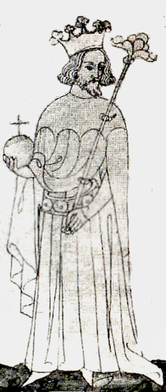 |
John the Blind |
10 August 1296 | 26 August 1346 | 24 August 1313 to 26 August 1346 |
his son |
| Charles I the Popish King Charles IV, Holy Roman Emperor Charles IV , born Wenceslaus , was the second king of Bohemia from the House of Luxembourg, and the first king of Bohemia to also become Holy Roman Emperor.... |
14 May 1316 | 29 November 1378 | 26 August 1346 to 1353 |
his son | |
| Wenceslaus I Wenceslaus I, Duke of Luxembourg Wenceslaus I was the first Duke of Luxembourg from 1355... |
25 February 1337 | 7 December 1383 | 1353 to 13 March 1354 |
his brother | |
House of Luxembourg-Limburg
| Image | Name | Date of birth | Date of death | Reign | Relationship with predecessor |
|---|---|---|---|---|---|
| Wenceslaus I Wenceslaus I, Duke of Luxembourg Wenceslaus I was the first Duke of Luxembourg from 1355... |
25 February 1337 | 7 December 1383 | 13 March 1354 to 7 December 1383 |
himself as count | |
 |
Wenceslas II the Lazy Wenceslaus, King of the Romans Wenceslaus ) was, by election, German King from 1376 and, by inheritance, King of Bohemia from 1378. He was the third Bohemian and second German monarch of the Luxembourg dynasty... |
26 February 1361 | 16 August 1419 | 7 December 1383 to 1388 |
his nephew |
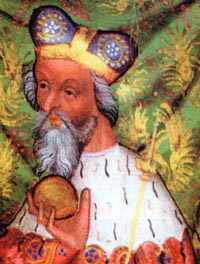 |
Jobst Jobst of Moravia Jobst of Moravia, Jobst von Mähren from the House of Luxembourg was the eldest son of Margrave John Henry of Moravia, the younger brother of Emperor Charles IV.... |
December 1351 | 18 January 1411 | 1388 to 18 January 1411 |
his cousin |
| Elisabeth I Elisabeth, Duchess of Luxembourg Elisabeth of Görlitz was Duchess regnant of Luxembourg from 1411 to 1443.-Life:Elisabeth was the only daughter and heiress of John of Görlitz, the third son of Charles IV, Holy Roman Emperor. He was Duke of Lusatia and Görlitz, and also Elector of Brandenburg for a brief period... |
November 1390 | 2 August 1451 | 18 January 1411 to 1443 |
his heiress & first cousin once removed | |
| Anthony Anthony, Duke of Brabant Anthony, Duke of Brabant, also known as Antoine de Brabant, Antoine de Bourgogne and Anthony of Burgundy , was Duke of Brabant, Lothier and Limburg. Anthony was the son of Philip II, Duke of Burgundy and Margaret III of Flanders, and brother of John the Fearless... |
August 1384 | 25 October 1415 | 18 January 1411 to 25 October 1415 |
her first husband and co-ruler | |
 |
John II the Pitiless |
1374 | 6 January 1425 | 10 March 1418 to 6 January 1425 |
her second husband and co-ruler Jure uxoris Jure uxoris is a Latin term that means "by right of his wife" or "in right of a wife". It is commonly used to refer to a title held by a man whose wife holds it in her own right. In other words, he acquired the title simply by being her husband.... |
As Elisabeth had no surviving children, she sold Luxembourg to Philip III, Duke of Burgundy
Philip III, Duke of Burgundy
Philip the Good KG , also Philip III, Duke of Burgundy was Duke of Burgundy from 1419 until his death. He was a member of a cadet line of the Valois dynasty . During his reign Burgundy reached the height of its prosperity and prestige and became a leading center of the arts...
in 1441 but only to succeed upon her death. Philip captured the city of Luxembourg
Luxembourg (city)
The city of Luxembourg , also known as Luxembourg City , is a commune with city status, and the capital of the Grand Duchy of Luxembourg. It is located at the confluence of the Alzette and Pétrusse Rivers in southern Luxembourg...
in 1443, but did not assume the ducal title because of conflicting claims by Anne of Austria
Anne, Duchess of Luxembourg
Anne of Bohemia and Austria was a Duchess of Luxembourg in her own right, and as consort, Landgravine of Thuringia and of Saxony....
, the closest Luxembourg relative.
Claimants
| Image | Name | Date of birth | Date of death | Reign | Relationship with predecessor |
|---|---|---|---|---|---|
| Elisabeth I Elisabeth, Duchess of Luxembourg Elisabeth of Görlitz was Duchess regnant of Luxembourg from 1411 to 1443.-Life:Elisabeth was the only daughter and heiress of John of Görlitz, the third son of Charles IV, Holy Roman Emperor. He was Duke of Lusatia and Görlitz, and also Elector of Brandenburg for a brief period... |
November 1390 | 2 August 1451 | 1443 to 2 August 1451 |
||
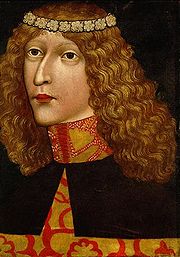 |
Ladislaus the Posthumous |
22 February 1440 | 23 November 1457 | 2 August 1451 to 23 November 1457 |
her first cousin once removed |
 |
Anne Anne, Duchess of Luxembourg Anne of Bohemia and Austria was a Duchess of Luxembourg in her own right, and as consort, Landgravine of Thuringia and of Saxony.... |
12 April 1432 | 13 November 1462 | 23 November 1457 to 13 November 1462 |
his sister |
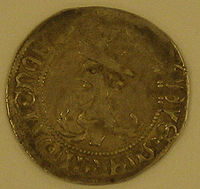 |
William the Brave William III, Duke of Luxembourg William III of Luxembourg , called the Brave , was Landgrave of Thuringia and Duke of Luxemburg... |
30 April 1425 | 17 September 1482 | her husband and co-pretender Jure uxoris Jure uxoris is a Latin term that means "by right of his wife" or "in right of a wife". It is commonly used to refer to a title held by a man whose wife holds it in her own right. In other words, he acquired the title simply by being her husband.... |
|
.jpg) |
Elisabeth II | 1436 | 30 August 1505 | 13 November 1462 to 1467 |
her sister |
 |
Casimir Jagiellon Casimir IV Jagiellon Casimir IV KG of the House of Jagiellon was Grand Duke of Lithuania from 1440, and King of Poland from 1447, until his death.Casimir was the second son of King Władysław II Jagiełło , and the younger brother of Władysław III of Varna.... |
30 November 1427 | 7 June 1492 | her husband and co-pretender Jure uxoris Jure uxoris is a Latin term that means "by right of his wife" or "in right of a wife". It is commonly used to refer to a title held by a man whose wife holds it in her own right. In other words, he acquired the title simply by being her husband.... |
|
House of Valois-Burgundy
In 1467, when Elisabeth II of AustriaElisabeth of Austria (d. 1505)
Elisabeth of Austria , , was a Polish-Lithuanian queen...
, last rival claimant to the title, renounced her rights, Philip III's son, Charles, Duke of Burgundy, assumed the title of duke of Luxembourg, making it a subsidiary title of the Duke of Burgundy
Duke of Burgundy
Duke of Burgundy was a title borne by the rulers of the Duchy of Burgundy, a small portion of traditional lands of Burgundians west of river Saône which in 843 was allotted to Charles the Bald's kingdom of West Franks...
.
| Image | Name | Date of birth | Date of death | Reign | Relationship with predecessor |
|---|---|---|---|---|---|
 |
Philip I the Good Philip III, Duke of Burgundy Philip the Good KG , also Philip III, Duke of Burgundy was Duke of Burgundy from 1419 until his death. He was a member of a cadet line of the Valois dynasty . During his reign Burgundy reached the height of its prosperity and prestige and became a leading center of the arts... |
31 July 1396 | 15 June 1467 | 1443 to 15 June 1467 |
Elisabeth I's second cousin once removed and usurper |
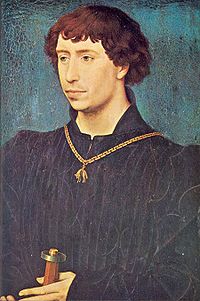 |
Charles II the Bold Charles I, Duke of Burgundy Charles the Bold , baptised Charles Martin, was Duke of Burgundy from 1467 to 1477... |
10 November 1433 | 5 January 1477 | 15 June 1467 to 5 January 1477 |
his son |
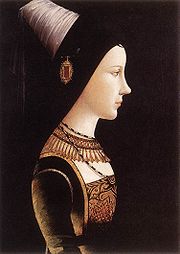 |
Mary I the Rich Mary of Burgundy Mary of Burgundy ruled the Burgundian territories in Low Countries and was suo jure Duchess of Burgundy from 1477 until her death... |
13 February 1457 | 27 March 1482 | 5 January 1477 to 27 March 1482 |
his daughter |
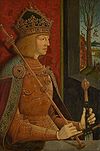 |
Maximilian I the Last Knight Maximilian I, Holy Roman Emperor Maximilian I , the son of Frederick III, Holy Roman Emperor and Eleanor of Portugal, was King of the Romans from 1486 and Holy Roman Emperor from 1493 until his death, though he was never in fact crowned by the Pope, the journey to Rome always being too risky... |
22 March 1459 | 12 January 1519 | her husband and co-ruler Jure uxoris Jure uxoris is a Latin term that means "by right of his wife" or "in right of a wife". It is commonly used to refer to a title held by a man whose wife holds it in her own right. In other words, he acquired the title simply by being her husband.... |
|
House of Habsburg
In 1482 Luxembourg passed to the House of Habsburg. After the abdication of Emperor Charles V, the duchy of Luxembourg fell to the Spanish line of the House of Habsburg.| Image | Name | Date of birth | Date of death | Reign | Relationship with predecessor |
|---|---|---|---|---|---|
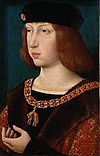 |
Philip II the Handsome Philip I of Castile Philip I , known as Philip the Handsome or the Fair, was the first Habsburg King of Castile... |
22 July 1478 | 25 September 1506 | 27 March 1482 to 25 September 1506 |
their son |
 |
Charles III the Golden One Charles V, Holy Roman Emperor Charles V was ruler of the Holy Roman Empire from 1519 and, as Charles I, of the Spanish Empire from 1516 until his voluntary retirement and abdication in favor of his younger brother Ferdinand I and his son Philip II in 1556.As... |
24 February 1500 | 21 September 1558 | 25 September 1506 to 16 January 1556 |
his son |
 |
Philip III the Prudent Philip II of Spain Philip II was King of Spain, Portugal, Naples, Sicily, and, while married to Mary I, King of England and Ireland. He was lord of the Seventeen Provinces from 1556 until 1581, holding various titles for the individual territories such as duke or count.... |
21 May 1527 | 21 September 1558 | 16 January 1556 to 13 September 1598 |
his son |
 |
Isabella Clara Eugenia Infanta Isabella Clara Eugenia of Spain Isabella Clara Eugenia of Austria was sovereign of the Spanish Netherlands in the Low Countries and the north of modern France, together with her husband Albert. In some sources, she is referred to as Clara Isabella Eugenia... |
12 August 1566 | 1 December 1633 | 6 May 1598 to 13 July 1621 |
his daughter |
| Albert Albert VII, Archduke of Austria Archduke Albert VII of Austria was, jointly with his wife, the Infanta Isabella Clara Eugenia, sovereign of the Habsburg Netherlands between 1598 and 1621, ruling the Habsburg territories in the southern Low Countries and the north of modern France... |
15 November 1559 | 13 July 1621 | his son-in-law | ||
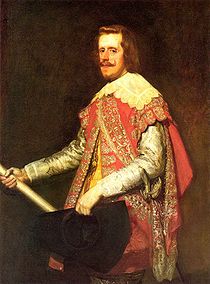 |
Philip IV the Great Philip IV of Spain Philip IV was King of Spain between 1621 and 1665, sovereign of the Spanish Netherlands, and King of Portugal until 1640... |
8 April 1605 | 17 September 1665 | 31 July 1621 to 17 September 1665 |
their nephew |
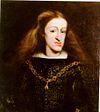 |
Charles IV the Bewitched Charles II of Spain Charles II was the last Habsburg King of Spain and the ruler of large parts of Italy, the Spanish territories in the Southern Low Countries, and Spain's overseas Empire, stretching from the Americas to the Spanish East Indies... |
6 November 1661 | 1 November 1700 | 17 September 1665 to 1 November 1700 |
his son |
During the War of Spanish Succession, 1701–1714, the duchy was disputed between Philip of Anjou
Philip V of Spain
Philip V was King of Spain from 15 November 1700 to 15 January 1724, when he abdicated in favor of his son Louis, and from 6 September 1724, when he assumed the throne again upon his son's death, to his death.Before his reign, Philip occupied an exalted place in the royal family of France as a...
, grandson of Louis XIV of France
Louis XIV of France
Louis XIV , known as Louis the Great or the Sun King , was a Bourbon monarch who ruled as King of France and Navarre. His reign, from 1643 to his death in 1715, began at the age of four and lasted seventy-two years, three months, and eighteen days...
, from the House of Bourbon
House of Bourbon
The House of Bourbon is a European royal house, a branch of the Capetian dynasty . Bourbon kings first ruled Navarre and France in the 16th century. By the 18th century, members of the Bourbon dynasty also held thrones in Spain, Naples, Sicily, and Parma...
and Charles of Austria
Charles VI, Holy Roman Emperor
Charles VI was the penultimate Habsburg sovereign of the Habsburg Empire. He succeeded his elder brother, Joseph I, as Holy Roman Emperor, King of Bohemia , Hungary and Croatia , Archduke of Austria, etc., in 1711...
, son of Leopold I, Holy Roman Emperor
Leopold I, Holy Roman Emperor
| style="float:right;" | Leopold I was a Holy Roman Emperor, King of Hungary and King of Bohemia. A member of the Habsburg family, he was the second son of Emperor Ferdinand III and his first wife, Maria Anna of Spain. His maternal grandparents were Philip III of Spain and Margaret of Austria...
, from the House of Habsburg. In 1712 Luxembourg
Luxembourg
Luxembourg , officially the Grand Duchy of Luxembourg , is a landlocked country in western Europe, bordered by Belgium, France, and Germany. It has two principal regions: the Oesling in the North as part of the Ardennes massif, and the Gutland in the south...
and Namur
Namur (city)
Namur is a city and municipality in Wallonia, in southern Belgium. It is both the capital of the province of Namur and of Wallonia....
were ceded to Maximilian II Emanuel, Elector of Bavaria
Maximilian II Emanuel, Elector of Bavaria
Maximilian II , also known as Max Emanuel or Maximilian Emanuel, was a Wittelsbach ruler of Bavaria and an elector of the Holy Roman Empire. He was also the last Governor of the Spanish Netherlands and duke of Luxembourg...
by his French allies, but with the end of the war in 1713 with the Treaty of Utrecht Max. Emanuel was restored Elector of Bavaria. In 1713 the duchy fell to the Austrian branch of the House of Habsburg.
House of Bourbon
| Image | Name | Date of birth | Date of death | Reign | Relationship with predecessor |
|---|---|---|---|---|---|
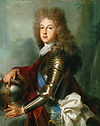 |
Philip V Philip V of Spain Philip V was King of Spain from 15 November 1700 to 15 January 1724, when he abdicated in favor of his son Louis, and from 6 September 1724, when he assumed the throne again upon his son's death, to his death.Before his reign, Philip occupied an exalted place in the royal family of France as a... Philippe de France |
19 December 1683 | 9 July 1746 | 1 November 1700 to 1712 |
his grandnephew |
House of Wittelsbach
| Image | Name | Date of birth | Date of death | Reign | Relationship with predecessor |
|---|---|---|---|---|---|
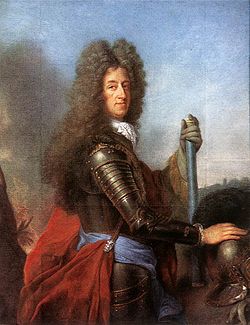 |
Maximilian II Maximilian II Emanuel, Elector of Bavaria Maximilian II , also known as Max Emanuel or Maximilian Emanuel, was a Wittelsbach ruler of Bavaria and an elector of the Holy Roman Empire. He was also the last Governor of the Spanish Netherlands and duke of Luxembourg... Maximilian Emanuel Ludwig Maria Joseph Kajetan Anton Nikolaus Franz Ignaz Felix |
11 July 1662 | 26 February 1726 | 1712 to 11 April 1713 |
his first cousin once removed |
House of Habsburg
| Image | Name | Date of birth | Date of death | Reign | Relationship with predecessor |
|---|---|---|---|---|---|
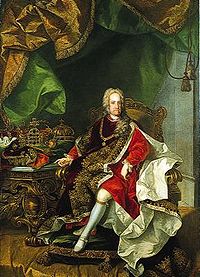 |
Charles V Charles VI, Holy Roman Emperor Charles VI was the penultimate Habsburg sovereign of the Habsburg Empire. He succeeded his elder brother, Joseph I, as Holy Roman Emperor, King of Bohemia , Hungary and Croatia , Archduke of Austria, etc., in 1711... Karl Franz Joseph Wenceslau Balthasar Johann Anton Ignatius |
1 October 1685 | 20 October 1740 | 11 April 1713 to 20 October 1740 |
his second cousin |
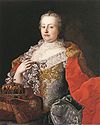 |
Maria II Theresa Maria Theresa of Austria Maria Theresa Walburga Amalia Christina was the only female ruler of the Habsburg dominions and the last of the House of Habsburg. She was the sovereign of Austria, Hungary, Croatia, Bohemia, Mantua, Milan, Lodomeria and Galicia, the Austrian Netherlands and Parma... Maria Theresa Walburga Amalia Christina |
13 May 1717 | 29 November 1780 | 20 October 1740 to 29 November 1780 |
his daughter |
House of Lorraine
| Image | Name | Date of birth | Date of death | Reign | Relationship with predecessor |
|---|---|---|---|---|---|
| Francis I Francis I, Holy Roman Emperor Francis I was Holy Roman Emperor and Grand Duke of Tuscany, though his wife effectively executed the real power of those positions. With his wife, Maria Theresa, he was the founder of the Habsburg-Lorraine dynasty... François Étienne |
8 December 1708 | 18 August 1765 | 21 November 1740 to 18 August 1765 |
her husband | |
| Joseph Joseph II, Holy Roman Emperor Joseph II was Holy Roman Emperor from 1765 to 1790 and ruler of the Habsburg lands from 1780 to 1790. He was the eldest son of Empress Maria Theresa and her husband, Francis I... Joseph Benedikt August Johannes Anton Michael Adam |
13 March 1741 | 20 February 1790 | 29 November 1780 to 20 February 1790 |
her son | |
| Leopold Leopold II, Holy Roman Emperor Leopold II , born Peter Leopold Joseph Anton Joachim Pius Gotthard, was Holy Roman Emperor and King of Hungary and Bohemia from 1790 to 1792, Archduke of Austria and Grand Duke of Tuscany from 1765 to 1790. He was a son of Emperor Francis I and his wife, Empress Maria Theresa... Peter Leopold Joseph Anton Joachim Pius Gotthard |
5 May 1747 | 1 March 1792 | 20 February 1790 to 1 March 1792 |
his brother | |
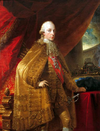 |
Francis II Francis II, Holy Roman Emperor Francis II was the last Holy Roman Emperor, ruling from 1792 until 6 August 1806, when he dissolved the Empire after the disastrous defeat of the Third Coalition by Napoleon at the Battle of Austerlitz... Francis Joseph Charles |
12 February 1768 | 2 March 1835 | 1 March 1792 to 1794 |
his son |
Luxembourg was occupied by French revolutionaries between 1794 and 1813. At the Vienna Congress, it was elevated to a grand duchy and given in personal union to William I of the Netherlands
William I of the Netherlands
William I Frederick, born Willem Frederik Prins van Oranje-Nassau , was a Prince of Orange and the first King of the Netherlands and Grand Duke of Luxembourg....
.
Grand Dukes of Luxembourg
The Grand Duke of Luxembourg is the head of stateHead of State
A head of state is the individual that serves as the chief public representative of a monarchy, republic, federation, commonwealth or other kind of state. His or her role generally includes legitimizing the state and exercising the political powers, functions, and duties granted to the head of...
of Luxembourg
Luxembourg
Luxembourg , officially the Grand Duchy of Luxembourg , is a landlocked country in western Europe, bordered by Belgium, France, and Germany. It has two principal regions: the Oesling in the North as part of the Ardennes massif, and the Gutland in the south...
. Luxembourg is the world's only sovereign extant Grand Duchy
Grand duchy
A grand duchy, sometimes referred to as a grand dukedom, is a territory whose head of state is a monarch, either a grand duke or grand duchess.Today Luxembourg is the only remaining grand duchy...
, a status to which Luxembourg was promoted in 1815 upon its unification with the Netherlands under the House of Orange-Nassau
House of Orange-Nassau
The House of Orange-Nassau , a branch of the European House of Nassau, has played a central role in the political life of the Netherlands — and at times in Europe — since William I of Orange organized the Dutch revolt against Spanish rule, which after the Eighty Years' War...
.
The Luxembourgian constitution
Constitution of Luxembourg
The Constitution of Luxembourg is the supreme law of the Grand Duchy of Luxembourg. The modern constitution was adopted on 17 October 1868.Whilst the constitution of 1868 marked a radical change in Luxembourg's constitutional settlement, it was technically an amendment of the original constitution...
defines the Grand Duke
Grand Duke
The title grand duke is used in Western Europe and particularly in Germanic countries for provincial sovereigns. Grand duke is of a protocolary rank below a king but higher than a sovereign duke. Grand duke is also the usual and established translation of grand prince in languages which do not...
's position:
House of Orange-Nassau
| Image | Name | Date of birth | Date of death | Reign | Relationship with predecessor |
|---|---|---|---|---|---|
 |
William I William I of the Netherlands William I Frederick, born Willem Frederik Prins van Oranje-Nassau , was a Prince of Orange and the first King of the Netherlands and Grand Duke of Luxembourg.... Willem Frederik (Prince William VI of Orange) |
24 August 1772 | 12 December 1843 | 15 March 1815 to 7 October 1840 |
Francis' third cousin and Anne Anne, Duchess of Luxembourg Anne of Bohemia and Austria was a Duchess of Luxembourg in her own right, and as consort, Landgravine of Thuringia and of Saxony.... 's direct descendant |
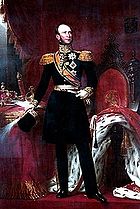 |
William II William II of the Netherlands William II was King of the Netherlands, Grand Duke of Luxembourg, and Duke of Limburg from 7 October 1840 until his death in 1849.- Early life and education :... Willem Frederik George Lodewijk |
6 December 1792 | 17 March 1849 | 7 October 1840 to 17 March 1849 |
his son |
.jpg) |
William III William III of the Netherlands William III was from 1849 King of the Netherlands and Grand Duke of Luxembourg until his death and the Duke of Limburg until the abolition of the Duchy in 1866.-Early life:William was born in Brussels as son of William II of the Netherlands and... Willem Alexander Paul Frederik Lodewijk |
17 February 1817 | 23 November 1890 | 17 March 1849 to 23 November 1890 |
his son |
House of Nassau-Weilburg
Under the 1783 Nassau Family PactNassau Family Pact
The Nassau Family Pact was a mutual pact of inheritance and succession made in 1783 by princes of the old German noble and sovereign family of Nassau. It confirmed Salic Law to operate in favor of all agnatic lines of the family, divided into first surviving lines which existed in the Middle Ages...
, those territories of the Nassau family in the Holy Roman Empire
Holy Roman Empire
The Holy Roman Empire was a realm that existed from 962 to 1806 in Central Europe.It was ruled by the Holy Roman Emperor. Its character changed during the Middle Ages and the Early Modern period, when the power of the emperor gradually weakened in favour of the princes...
at the time of the Pact (Luxembourg and Nassau
Nassau (state)
Nassau was a German state within the Holy Roman Empire and later in the German Confederation. Its ruling dynasty, now extinct in male line, was the House of Nassau.-Origins:...
) were bound by semi-Salic law
Salic law
Salic law was a body of traditional law codified for governing the Salian Franks in the early Middle Ages during the reign of King Clovis I in the 6th century...
, which allowed inheritance
Inheritance
Inheritance is the practice of passing on property, titles, debts, rights and obligations upon the death of an individual. It has long played an important role in human societies...
by females or through the female line only upon extinction of male members of the dynasty
Dynasty
A dynasty is a sequence of rulers considered members of the same family. Historians traditionally consider many sovereign states' history within a framework of successive dynasties, e.g., China, Ancient Egypt and the Persian Empire...
. When William III
William III of the Netherlands
William III was from 1849 King of the Netherlands and Grand Duke of Luxembourg until his death and the Duke of Limburg until the abolition of the Duchy in 1866.-Early life:William was born in Brussels as son of William II of the Netherlands and...
died leaving only his daughter Wilhelmina
Wilhelmina of the Netherlands
Wilhelmina was Queen regnant of the Kingdom of the Netherlands from 1890 to 1948. She ruled the Netherlands for fifty-eight years, longer than any other Dutch monarch. Her reign saw World War I and World War II, the economic crisis of 1933, and the decline of the Netherlands as a major colonial...
as an heir, the crown of the Netherlands, not being bound by the family pact, passed to Wilhelmina. However, the crown of Luxembourg passed to a male of another branch of the House of Nassau: Adolphe
Adolphe, Grand Duke of Luxembourg
Adolphe I, Grand Duke of Luxembourg was the last Duke of Nassau, and the fourth Grand Duke of Luxembourg.-Biography:...
, the dispossessed Duke of Nassau and head of the branch of Nassau-Weilburg.
In 1905, Grand Duke Adolphe's younger half-brother, Prince Nikolaus Wilhelm of Nassau
Nikolaus Wilhelm of Nassau
Nikolaus Wilhelm, Prince of Nassau , was the only son of William, Duke of Nassau by his second wife Princess Pauline of Württemberg.-Marriage and issue:...
, died, having left a son Georg Nikolaus, Count von Merenberg
Count of Merenberg
Count of Merenberg is the title bestowed in 1868 by the reigning Prince of Waldeck and Pyrmont, George Victor, upon the morganatic wife and male-line descendants of Prince Nikolaus Wilhelm of Nassau , who married Natalia Alexandrovna Pushkina , former wife of Russian General Mikhail Leontievich...
who was, however, the product of a morganatic marriage
Morganatic marriage
In the context of European royalty, a morganatic marriage is a marriage between people of unequal social rank, which prevents the passage of the husband's titles and privileges to the wife and any children born of the marriage...
, and therefore not legally a member of the House of Nassau. In 1907, Adolphe's only son, William IV, Grand Duke of Luxembourg, obtained passage of a law confirming the right of his eldest daughter, Marie-Adélaïde, to succeed to the throne in virtue of the absence of any remaining dynastic
Dynasty
A dynasty is a sequence of rulers considered members of the same family. Historians traditionally consider many sovereign states' history within a framework of successive dynasties, e.g., China, Ancient Egypt and the Persian Empire...
males of the House of Nassau, as originally stipulated in the Nassau Family Pact. She became the grand duchy's first reigning female monarch upon her father's death in 1912, and upon her own abdication
Abdication
Abdication occurs when a monarch, such as a king or emperor, renounces his office.-Terminology:The word abdication comes derives from the Latin abdicatio. meaning to disown or renounce...
in 1919, was succeeded by her younger sister Charlotte
Charlotte, Grand Duchess of Luxembourg
Charlotte, Grand Duchess of Luxembourg was the reigning Grand Duchess of Luxembourg from 1919 to 1964.-Early life and life as Grand Duchess:...
, who married Felix of Bourbon-Parma
Felix of Bourbon-Parma
Prince Félix of Bourbon-Parma , later Prince Félix of Luxembourg, was the husband of Charlotte, Grand Duchess of Luxembourg and the father of her six children, including Jean, Grand Duke of Luxembourg.-Early life:Prince Félix was one of the...
, a prince of the former Duchy of Parma
Duchy of Parma
The Duchy of Parma was created in 1545 from that part of the Duchy of Milan south of the Po River, as a fief for Pope Paul III's illegitimate son, Pier Luigi Farnese, centered on the city of Parma....
. Charlotte's descendants have since reign
Reign
A reign is the term used to describe the period of a person's or dynasty's occupation of the office of monarch of a nation or of a people . In most hereditary monarchies and some elective monarchies A reign is the term used to describe the period of a person's or dynasty's occupation of the office...
ed as the continued dynasty of Nassau, and also constitute a cadet branch
Cadet branch
Cadet branch is a term in genealogy to describe the lineage of the descendants of the younger sons of a monarch or patriarch. In the ruling dynasties and noble families of much of Europe and Asia, the family's major assets – titles, realms, fiefs, property and income – have...
of the House of Bourbon-Parma.
| Image | Name | Date of birth | Date of death | Reign | Relationship with predecessor |
|---|---|---|---|---|---|
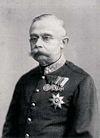 |
Adolphe Adolphe, Grand Duke of Luxembourg Adolphe I, Grand Duke of Luxembourg was the last Duke of Nassau, and the fourth Grand Duke of Luxembourg.-Biography:... |
24 July 1817 | 17 November 1905 | 23 November 1890 to 17 November 1905 |
his nephew |
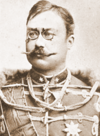 |
William IV | 22 April 1852 | 25 February 1912 | 17 November 1905 to 25 February 1912 |
his son |
 |
Marie-Adélaïde | 14 June 1894 | 24 January 1924 | 25 February 1912 to 14 January 1919 |
his daughter |
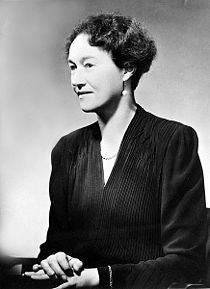 |
Charlotte Charlotte, Grand Duchess of Luxembourg Charlotte, Grand Duchess of Luxembourg was the reigning Grand Duchess of Luxembourg from 1919 to 1964.-Early life and life as Grand Duchess:... |
23 January 1896 | 9 July 1985 | 14 January 1919 to 12 November 1964 |
her sister (younger daughter of William IV) |
 |
Jean Jean, Grand Duke of Luxembourg Grand Duke Jean of Luxembourg ruled Luxembourg from 1964 to 2000. He is the father of the current ruler, Grand Duke Henri, and the son of Grand Duchess Charlotte and Prince Felix of Bourbon-Parma... |
5 January 1921 | Living | 12 November 1964 to 7 October 2000 |
her son |
.jpg) |
Henri Henri, Grand Duke of Luxembourg Henri, Grand Duke of Luxembourg OIH is the head of state of Luxembourg. He is the eldest son of Jean, Grand Duke of Luxembourg and Princess Joséphine-Charlotte of Belgium. His maternal grandparents were King Leopold III of Belgium and Astrid of Sweden... |
16 April 1955 | Living | From 7 October 2000 (Incumbent) |
his son |
See also
- Coat of arms of LuxembourgCoat of arms of LuxembourgThe coat of arms of Luxembourg has its origins in the Middle Ages, and was derived from that of the Duchy of Limburg, in modern day Belgium and the Netherlands...
- Duchy of Luxembourg
- Grand Ducal Family of LuxembourgGrand Ducal Family of LuxembourgThe Grand Ducal Family of Luxembourg consists of the extended family of the sovereign Grand Duke....
- History of LuxembourgHistory of LuxembourgThe history of Luxembourg is inherently entwined with the histories of surrounding countries, peoples, and ruling dynasties. Over time, the territory of Luxembourg has been eroded, whilst its ownership has changed repeatedly, and its political independence has grown gradually.'Although recorded...
- Line of succession to the throne of Luxembourg
- List of consorts of Luxembourg
- List of Prime Ministers of Luxembourg

